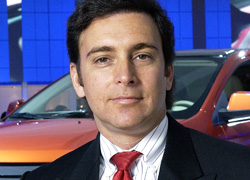
DETROIT – Two major changes to the automotive landscape in 2006 have helped lay the path Ford Motor Co. will follow in the future, a top executive says.
A softening truck market is the first development causing the auto maker concern, says Mark Fields, president-The Americas, who blames the downturn on a weakening housing market and competitors’ over-use of incentives to move large trucks off dealers’ lots.
The second factor dramatically influencing the auto industry is the rapid escalation of gasoline prices that occurred earlier this year.
The shift in the lucrative truck segment hurts, Fields tells Ward’s at a North American International Auto Show media preview event here.
“But at the same time, we’ve seen the market become a lot more competitive and very irrational because of people who haven’t managed their business appropriately,” he says.
Through November, sales of Ford’s venerable F-Series pickup were off 10.7% to 725,459 units, according to Ward’s data.
Although fuel prices have somewhat stabilized in recent months, Fields says the spike was enough to permanently change the mindset of many car buyers.

“When you look at reports on what’s important to consumers and their purchase criteria, fuel efficiency is still very high,” he says. “I think consumers, in their own minds, have said gas prices will continue to be volatile and it’s not going back to the good ole days.”
To keep pace with the rapidly changing marketplace and increasingly fickle customers, Ford plans to leverage its worldwide operations in order to respond to the U.S. market more quickly, Fields says, admitting the auto maker in the past has not operated as one globally cohesive unit.
“We have to get a lot better at sharing our global resources,” he says. “If you do the first part right, with the investment and engineering efficiencies you get, you can reinvest a lot of that money.”
Meanwhile, Fields says Ford intends to stabilize its North American retail market share at about 11%, while lowering its fleet share to about 4%.
“(Market share) is going to wiggle, depending on the month or when our products will be coming out during the year,” he says.
Fields also says an announcement on whether Ford will build a low-cost greenfield plant somewhere in North America will not be made by the end of the year as originally planned. When Ford announced its original Way Forward restructuring plan Jan. 23, it also said a new low-cost manufacturing site was planned for the future.
Fields now says a new plant, possibly to build small, B-segment cars for the North American market, is “still under consideration.”
“We’re still working through the business case, looking at our product plan and how we’ll leverage our global resources. We’ve never said it’s an absolute given,” says Fields, noting a final decision on the plant will be made sometime next year.



